The advice given here are only suggestions and each situation is different and must be treated as such.
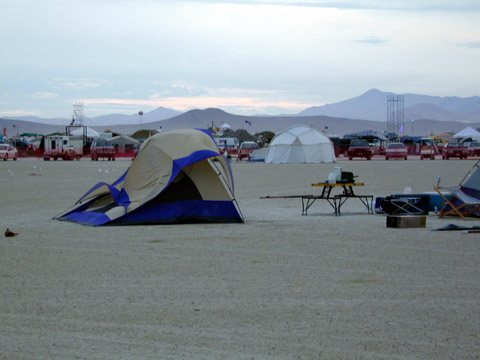
Wind is the most destructive natural element to tents and other light weight shelters. Strong wind will flap, smash, and blow away your shelter in short order if it is not designed for the wind or properly secured.
To withstand strong wind a tent needs to be drum tight and successful shed the wind. We have designed out Yurt Domes to hold up to strong wind. They are drum tight and shed the wind well. We do not recommend them for extreme wind. The winds at Burning Man can be extreme and extra care needs be taken to survive there.
The tent in front is getting smashed by the wind while the 18 ‘ Yurt Dome in the background stands strong.Be aware that all structures have their wind load limit. It is by far better to take down a tent before the wind. gets to strong then to have it fail in high wind. At the same time it is hard to know when to do this and taking down a tent in strong wind can be dangerous to you and or your tent. Taking down a tent in high wind weakens it and can cause the wind to get a better hold on the tent which can cause it to fail or get away from you. A failing tent can cause poles to brake and fly at you or others. Be extremely careful when you are around tents in high wind. Stay clear of failing tents and advise others to do so.
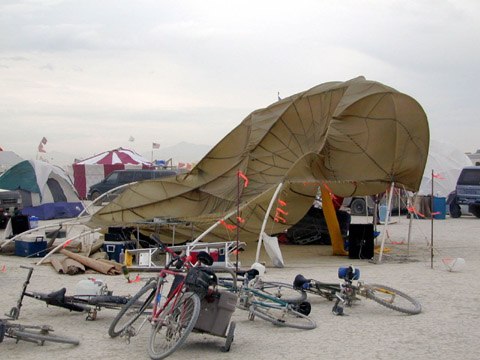
We will describe how to best prepare your Shelter Systems’ Yurt Dome for the wind. Some of this information may or may not be useful for other tents you my choose to use. Keep in mind when choosing a tent that it must be strong and resilient.
The best is to avoid the wind by choosing wind protected places to pitch your tent. Of course this cannot be done if you are on at Burning Man. If high wind comes up take your tent down before the wind gets too strong. Next best is to protect your tent from the wind with wind blocks such as snow fencing, bales of hay, buildings, cars, etc. Next make sure you secure your tent to the ground in a way that it will not come loose. Wind over time will cause your tent to move up and down and side to side therefore your ground stakes need to be checked frequency to see if they are working loose Check to see that the cords you run from your tent to the stakes does not become frayed by this friction. If you use rebar as stakes make sure the ends of the rebar are covered with bottles or preferably bent into a “U” shape so you will not cut your foot or leg on the exposed bar.
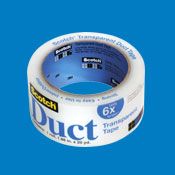 Dealing with wind blown dust and/or high wind conditions. Get Scotch Heavy Duty GrayAll-Weather Duct Tape and or Scotch Transparent Long Lasting Duct Tape (regular duct tape does not hold up in the sun) both tapes are available at many hardware stores and we offer the Transparent Tape. The Heavy Duty lasts a bit longer in the sun then the Transparent but both hold up well over time. The Transparent looks better. Use for sealing up unused doors, floor to wall or shingleing when in extream dust conditions. Apply tape to dome when it is clean and dry Use only one door for entering and exiting your dome. Seal your other doors with tape. Attach sticky back Velcro on the door you use (apply when clean and dry – it takes about 24 hours for the glue on the velcro to set to full strength). Consider using just one side of your door when conditions are windy. Tuck your dome’s skirt under your tarp floor and then tape your floor to your dome’s skirt on the inside of your dome. Weight down your floor with all the objects you have (in high wind, wind will blow under your floor and lift it up shaking dust into the air. Seal the horizontal shingles with tape on the windward side of your dome and or any shingle that leaks dust.
Dealing with wind blown dust and/or high wind conditions. Get Scotch Heavy Duty GrayAll-Weather Duct Tape and or Scotch Transparent Long Lasting Duct Tape (regular duct tape does not hold up in the sun) both tapes are available at many hardware stores and we offer the Transparent Tape. The Heavy Duty lasts a bit longer in the sun then the Transparent but both hold up well over time. The Transparent looks better. Use for sealing up unused doors, floor to wall or shingleing when in extream dust conditions. Apply tape to dome when it is clean and dry Use only one door for entering and exiting your dome. Seal your other doors with tape. Attach sticky back Velcro on the door you use (apply when clean and dry – it takes about 24 hours for the glue on the velcro to set to full strength). Consider using just one side of your door when conditions are windy. Tuck your dome’s skirt under your tarp floor and then tape your floor to your dome’s skirt on the inside of your dome. Weight down your floor with all the objects you have (in high wind, wind will blow under your floor and lift it up shaking dust into the air. Seal the horizontal shingles with tape on the windward side of your dome and or any shingle that leaks dust.
Anchoring: Wear gloves and eye 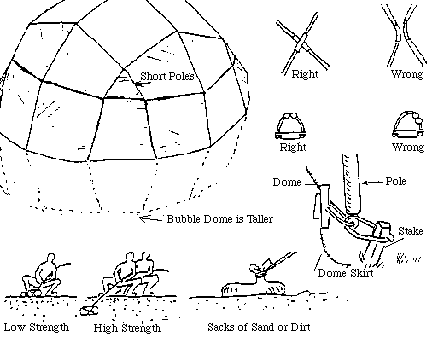 protection. Your dome is no stronger than its anchors, so it is important to anchor it securely. We have provided you with
protection. Your dome is no stronger than its anchors, so it is important to anchor it securely. We have provided you with 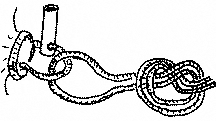 short cords. Tie them to the base of the attached Grip Clip™ strings that are around the perimeter of your dome. You now have a loop to pull out and drive your stake through. (some domes may already have “stake cords” attached). To assure the dome’s edge is an even tight circle, place stakes lightly at every other pole base. Then go around pulling, tightening and adjusting the circle, driving the stakes deep after adjustment. Add the remaining stakes. If the stakes we have provided go into the ground easily, then this type of soil requires longer stakes. Make stakes from 2″x 2″ lumber with a hole 2″ from the top. Logs or sandbags filled with sand or gravel work and can be buried for extra security in soils too loose for your stakes to work.
short cords. Tie them to the base of the attached Grip Clip™ strings that are around the perimeter of your dome. You now have a loop to pull out and drive your stake through. (some domes may already have “stake cords” attached). To assure the dome’s edge is an even tight circle, place stakes lightly at every other pole base. Then go around pulling, tightening and adjusting the circle, driving the stakes deep after adjustment. Add the remaining stakes. If the stakes we have provided go into the ground easily, then this type of soil requires longer stakes. Make stakes from 2″x 2″ lumber with a hole 2″ from the top. Logs or sandbags filled with sand or gravel work and can be buried for extra security in soils too loose for your stakes to work.
When you put up the dome be wind wise: Even though the dome is freestanding and does not need to be staked out to stand, you should always stake it down as sometimes a gust of wind will come up unexpectedly and grab the dome out of your hands. If you have some one holding the dome against the wind have them hold onto a clip cord not a pole as the wind could cause the pole to be pulled out of the dome’s connectors and again the dome could blow away.
Check your stakes frequently (since ground conditions can change when wet) by pulling on them. You should just barely be able to pull them out. To anchor to adeck, use eye bolts attached to the 2″x 6″s set below the level of the deck.
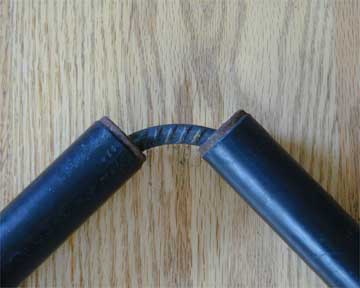
The best is to avoid the wind by choosing wind protected places to pitch your tent. Of course this cannot always be done. If high wind comes up take your tent down before the wind gets too strong. Next best is to protect your tent from the wind with wind blocks such as snow fencing, bales of hay, buildings, cars, etc. Next make sure you secure your tent to the ground in a way that it will not come loose. Wind over time will cause your tent to move up and down and side to side therefore your ground stakes need to be checked frequently to see if they are working loose Check to see that the cords you run from your tent to the stakes does not become frayed by this friction. If you use re-bar as stakes make sure the ends of the re-bar are covered with bottles or preferably bent into a “U” shape so you will not cut your foot or leg on the exposed bar.
All tents including dome tents will fail if the wind is strong enough, no matter how they are tied down. Indeed all structures will fail if loaded enough. Size is important: a larger dome catches more wind and must be much stronger to hold the wind. Our stronger domes are: 10′, 18′ and 30′ and these will hold up well in most storms. If you should get a freak wind your dome may still fail; in most cases only some poles will brake (these and PVC and are easy and cheep to repair replace) and your dome can be put up after the wind has passed. You can also if you have warning of a storm coming your way remove the lower level of poles and then re-secure your dome to the ground. This will make for a more streamlined affront to the wind.
Standard Stakes
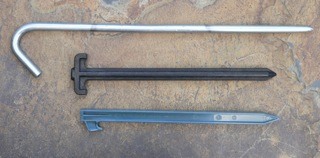 All our Yurt Dome and Gro Domes come with a complete set of stakes made of high-impact ABS. They are 12″ long and have excellent holding power in most soils. Use strong durable cord to knot a stake loop through the Grip Clip cords at the base of your dome. Follow the knotting procedure described in the manual. Drive the stakes thru these loop cords so hook points away from dome and deep enough so that the hook so it enters the ground a short distance. Always wear eye protection when driving or removing stakes.
All our Yurt Dome and Gro Domes come with a complete set of stakes made of high-impact ABS. They are 12″ long and have excellent holding power in most soils. Use strong durable cord to knot a stake loop through the Grip Clip cords at the base of your dome. Follow the knotting procedure described in the manual. Drive the stakes thru these loop cords so hook points away from dome and deep enough so that the hook so it enters the ground a short distance. Always wear eye protection when driving or removing stakes.
Price: Set of of 4 for $16 or Set of 12 for $38.
ExtraStrong Stakes
These almost indestructible 12″ stakes are highly recommended for hard, dry or compacted soils. Made from high impact glass filled resin.Use strong durable cord to knot a stake loop through the Grip Clip cords at the base of your dome. Follow the knotting procedure described in the manual. Drive the stakes thru these loop cords so hook points away from dome and deep enough so that the hook so it enters the ground a short distance. Always wear eye protection when driving and removing stakes.
Price: Set of 4 for $21, or Set of 12 for $58.
SuperStakes™
Super strong 18″ galvanized steel stakes for extra holding power or soil with some rocks. Use strong durable cord to knot a stake loop through the Grip Clip cords at the base of your dome. Follow the knotting procedure described in the manual. Drive the stakes thru these loop cords so hook points away from dome and deep enough so that the hook so it enters the ground a short distance. Always wear eye protection when driving and removing stakes. To remove stake from the ground slip another stake under the hook and lever the stake free. Always wear eye protection when driving stakes.
Price Set of 4 for $38, or Set of 12 for $113.
Anchoring in sand:
The best way is with what is called “dead man anchors”: where you bury in the sand a section of a log about 6″ in diameter and 2′ long that has a length of rot proof rope attached to the center of the log. Pull up hard on the rope and if you can lift the log then bury it deeper. You should put up the dome first on a windless day if possible and set it were you want it, to locate where the 12 anchors should be buried. Then move the dome out of the way and bury your anchors.
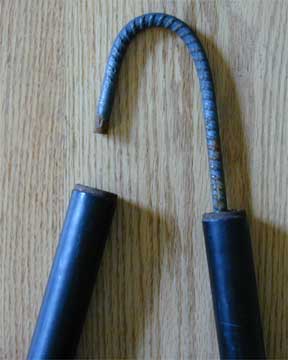
Anchoring into rocky ground:
Wear gloves and eye protection. With a one foot section of re bar or a 10″ or 12″ “spike” (large nail) and a heavy headed hammer pound the re-bar or nail into the ground where you want to place your stake. Before the re-bar is buried loosen it with the hammer by hitting the re-bar on the side that is above the ground. Pull the re-bar out and now pound in your stake. If all you have are rocks use a heavy cord (at least 3/8″) to run from the dome’s 12 anchor clips to 12 large rocks. Then pile up rocks on top of these rocks. Best to over do this than under do it.
Making your own re-bar stakes.
You can make re-bar stakes by bending lengths of re bar into a U shape at the top of the stake. Slip over each end of a 2′ lengths of re- bar 3 or 4′ sections of steel pipe and then by holding on to the ends of the pipes bend the bar.
Avoid rebar friction
Strong wind pushing and pulling on the dome, will cause the stake cord to rub up and down on the ruff re-bar (like a saw blade) there by cutting through the cord. The way around this is to tie the base clip cords to the re-bar with sections of 3/8″ or thicker cord. (The clip cords that we provide with our domes are only 1/8″ and are designed for the plastic stakes not re-bar.
Long, very strong, Foundation Stakes for soft or rocky ground. Another way to create longer and 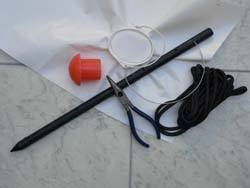 much stronger stakes buy foundation stakes from your building supply store, galvanized steel wire, 1/4″ nylon cord and plastic end caps forthe stakes.
much stronger stakes buy foundation stakes from your building supply store, galvanized steel wire, 1/4″ nylon cord and plastic end caps forthe stakes.
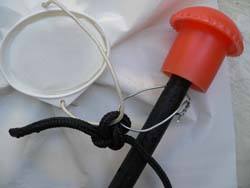
These stakes are available in lengths from 18″ to 4 feet. Use pliers to create a loop through the top most hole in the stake. Twist and then bend then ends of the wire so they will not cut the cord or you.
Use a small sledge hammer to drive the stake into the ground till only the top 4″ is protruding. Use the 1/4″ cord to tie the wire to your domes bottom clip cords. Now most importantly put the plastic end cap on the top of the stake as you can do great harm to your feet with our this cap. If the cap is knocked off be sure to replace it.
Always incorporate a strong bungee cord into your guy lines. By “strong” we mean a bungee that you can just barely stretch when you pull on it with both hands if you can not find ones that strong then tie a weaker one into a loop or joining one or more together. Tie one end each guy line 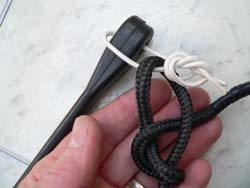 to a bungee and then tie the other end of the bungee to a secure stake. Guying: In wind, always set 4 to 12 guy lines. Run a line from the clip cords (if you tie to poles the wind will pull out the poles) to trees, stakes, large rocks or buried objects in the soil. In high winds check guys and anchors frequently, adding more if necessary. Even if you anchor your dome well, extreme wind can rip the guy line clips off your cover and poles off your dome and your dome will fail.
to a bungee and then tie the other end of the bungee to a secure stake. Guying: In wind, always set 4 to 12 guy lines. Run a line from the clip cords (if you tie to poles the wind will pull out the poles) to trees, stakes, large rocks or buried objects in the soil. In high winds check guys and anchors frequently, adding more if necessary. Even if you anchor your dome well, extreme wind can rip the guy line clips off your cover and poles off your dome and your dome will fail.
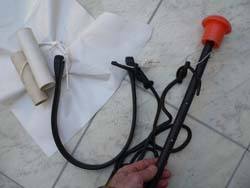
If you expect a storm with strong winds, consider removing the lower 12 poles, leaving the dome anchored. Then run strings back and forth across the dome, going from stake to stake to keep the wind from liftingup on the covering. If the dome still appears to be buffeted excessively by the wind, remove the remaining poles and lash the covering to the ground again by running strings back and forth from theanchors. When the storm passes, put the dome back up.
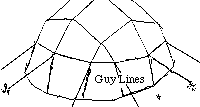
The best way to anchor a dome when you only have asphalt to set-up on. If you can drive steel stakes into the asphalt then use the instructions above in the manual for staking using “foundation stakes”. If you are not allowed to drive stakes into the asphalt then use large water containers ( 55 gal plastic drums) as anchors at each of the domes lower anchor clips (12 drums on the 14′, 18′ and 20′ and 20 drums on the 30′ Attach 3′ by 3 ‘ sections of tarps to the bottom Grip Clips of the dome with a heavy duty Grip Clip ( when attaching this Heavy Duty Clip – layer in 3 additional 10″ by 10″ patch layers of tarp – this added thickness should assure that the Grip Clip you are attaching does not slip on the tarp sections). Check to see that the clip does not slip. Set the empty drums over these attached tarps and then fill the drums with water. Test to see that you can not pull the tarp out from under the drums. Tie these clips securely to the domes anchor clips. In addition you can run a rope through the two opening at the top of the drums and tie this to clip cords above the top of the drum as guys. The dome may be held down with a sufficient number of sand bags tied to the domes anchor clips and weighting down the domes skirt but this will require a very large number of bags. Do NOT underestimate the strength of the wind. If you can move the anchor clips they are NOT secure and your dome could blow away or cause extreme damage.
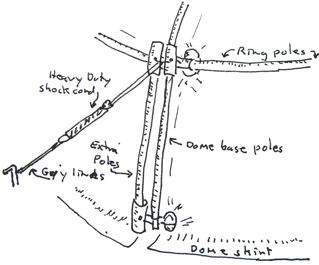
Another way to make your dome stronger in the wind is to add an additional set of “base poles” (12 extra poles for the 14′, 18′, and 20′) (20 extra poles for the 30′ or 31′).
You will also need two “connectors” and two ” clip cords” for each of your extra base poles so you can tie them tightly to the Grip Clips cords that support the existing dome’s base poles.
This is best done with your dome set up. Tie the connectors tight to the Grip Clip cords above and below the domes base poles and then bend and insert your extra poles into these connectors.
You do not have to remove these connectors when you take the dome down. Just remove the extra poles by bending as you would any of the other domes poles. With your dome well staked out set guy-lines off of each the clip cords at the top of your base poles. Be sure to hang strips of cloth, etc. to your guy-lines to avoid tripping hazards. Include a heavy duty shock cord in each of your guy-lines so that the dome will have some give and take.
Wind and Snow Warning
Shelter Systems’ Domes are stronger for their weight and the materials used than any other structure. Still they are light weight portable structures and as such are not designed to hold unusually strong wind, year round wind or much snow.
When possible, avoid exposed hilltops and narrow valleys where wind speed increases. Trees and  brush between you and the wind help protect your shelter. If you do not have natural protection from the wind you can create a wind screen out of straw bales. Your dome could be destroyed in extreme weather and your life or safety could be at risk. In heavy snow or wind your dome could collapse, damaging what you have or compromising your shelter. Do not rely on your dome as your only shelter. Accumulated snow, must be melted or shaken off.
brush between you and the wind help protect your shelter. If you do not have natural protection from the wind you can create a wind screen out of straw bales. Your dome could be destroyed in extreme weather and your life or safety could be at risk. In heavy snow or wind your dome could collapse, damaging what you have or compromising your shelter. Do not rely on your dome as your only shelter. Accumulated snow, must be melted or shaken off.
Just as you would not expect to be able to climb up on top of your dome and have it hold you, it will not support much snow. If you plan to use your dome in the snow you will need to knock off the snow periodically or melt it off with heat from with in the dome. If the dome should collapse some poles may brake (these are easy to repair or inexpensive to replace) with unusually little or no damage to the covering. However items stored inside could be damaged by the weight or melting of the snow.
The covering will have a shorten life in areas that have constant winds. The dome’s covering can fail or the covering be ripped from the clips in extreme wind.
If your dome is free from its anchors it can tumble and blow away and possibly collide with and damage people or property. Do not let your dome get away from you anchor it well.
Even if you anchor your dome well, extreme wind can rip the guy line clips and poles off your dome and your dome will fail.
WARNING: Your Yurt Dome shelter could be destroyed in extreme weather and your life or safety could be at risk. In heavy snow or wind your Yurt Dome could collapse, damaging what you have or compromising your shelter. Do not rely on your Yurt Dome as your only shelter. Accumulated snow, must be melted or shaken off periodically. Do not set your Your Dome under a tree or branch that might fall on you. Keep all flames and heat away from your Yurt Dome’s covering and objects in your yurt dome
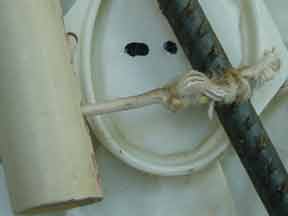
Watch out for rebar and stake friction
One thing we noticed at Burning Man was the wearing out of base clip cords where people were staking their dome with re-bar. This happens because of the wind pushing and pulling on the dome, causing the cord to rub up and down on the ruff re-bar (like a saw blade) there by cutting through the cords. The way around this is to tie the base clip cords to the re-bar with sections of 3/8″ or thicker cord. (The clip cords that we provide with our domes are only 1/8″ and are designed for the plastic stakes not re-bar.)
Anchoring: Your dome is no stronger than its anchors, so it is important to anchor it securely. Be sure to read your Instruction Manual section on anchoring carefully. If your dome is free from its anchors it can tumble and blow away and possibly collide with and damage people or property. Do not let your dome get away from you; anchor it well. Even if you anchor your dome well, extreme wind can rip the guy line clips and poles off your dome and your dome will fail.

WARNING: Your Yurt Dome shelter could be destroyed in extreme weather and your life or safety could be at risk. In heavy snow or wind your Yurt Dome could collapse, damaging what you have or compromising your shelter. Do not rely on your Yurt Dome as your only shelter. Accumulated snow, must be melted or shaken off periodically. Do not set your Your Dome under a tree or branch that might fall on you. Keep all flames and heat away from your Yurt Dome’s covering and objects in your yurt dome.
Shelter Systems’ Domes are stronger for the materials used than any other structure. Still they are light weight portable structures and as such are not designed to hold unusually strong wind, year round wind or much snow.
Avoid exposed hilltops and narrow valleys where wind speed increases. Trees and  brush between you and the wind help protect your shelter. If you do not have natural protection from the wind you can create a wind screen out of straw bales. Your dome could be destroyed in extreme weather and your life or safety could be at risk. In heavy snow or wind your dome could collapse, damaging what you have and or compromising your shelter. Do not rely on your dome as your only shelter. Accumulated snow, must be melted or shaken off.
brush between you and the wind help protect your shelter. If you do not have natural protection from the wind you can create a wind screen out of straw bales. Your dome could be destroyed in extreme weather and your life or safety could be at risk. In heavy snow or wind your dome could collapse, damaging what you have and or compromising your shelter. Do not rely on your dome as your only shelter. Accumulated snow, must be melted or shaken off.
Just as you would not expect to be able to climb up on top of your dome and have it hold you, it will not support much snow. If you plan to use your dome in the snow you will need to knock off the snow periodically or melt it off with heat from with in the dome. If the dome should collapse some poles may break (these are easy to repair or inexpensive to replace) with unusually little or no damage to the covering. However items stored inside could be damaged by the weight or melting of the snow.
Our two strongest domes are the 18′ and the 30′. Tents by nature are light weight and portable but problematic in strong or continual winds. Our domes, for the materials used, we believe are the strongest in the world but this will not keep them from failing in extreme conditions. Constant wind will wear on components until one part fails causing the rest of the structure to fail. Be sure to read our manual about wind and anchoring: https://shelter-systems.com/lighthouse-manual/
The covering will have a shorten life in areas that have constant winds. The dome’s covering can fail or the covering be ripped from the clips in extreme wind.
Anchoring: Your dome is no stronger than its anchors, so it is important to anchor it securely. Be sure to read your Instruction Manual section on anchoring carefully.
If your dome works free from its anchors it can tumble and blow away and possibly collide with and damage people or property. It can also damage the dome’s covering. Do not let your dome get away from you. Anchor it well. Check your Anchors often. If in doubt about your dome standing up to the wind take it down and store it till the wind passes. Or remove the poles and run a rope back and forth many times from stake to stake over the collapsed covering till the wind passes. Do Not Under Estimate The Wind.
Even if you anchor your dome well, extreme wind can rip the guy line clips and poles off your dome and your dome can fail.
WARNING: Your Yurt Dome shelter could be destroyed in extreme weather and your life or safety could be at risk. In heavy snow or wind your Yurt Dome could collapse, damaging what you have or compromising your shelter. Do not rely on your Yurt Dome as your only shelter. Accumulated snow, must be melted or shaken off periodically. Do not set your Your Dome under a tree or branch that might fall on you. Keep all flames and heat away from your Yurt Dome’s covering and objects in your yurt dome.
